Radio-Orienteering Events in 2010
(In reverse order by date)
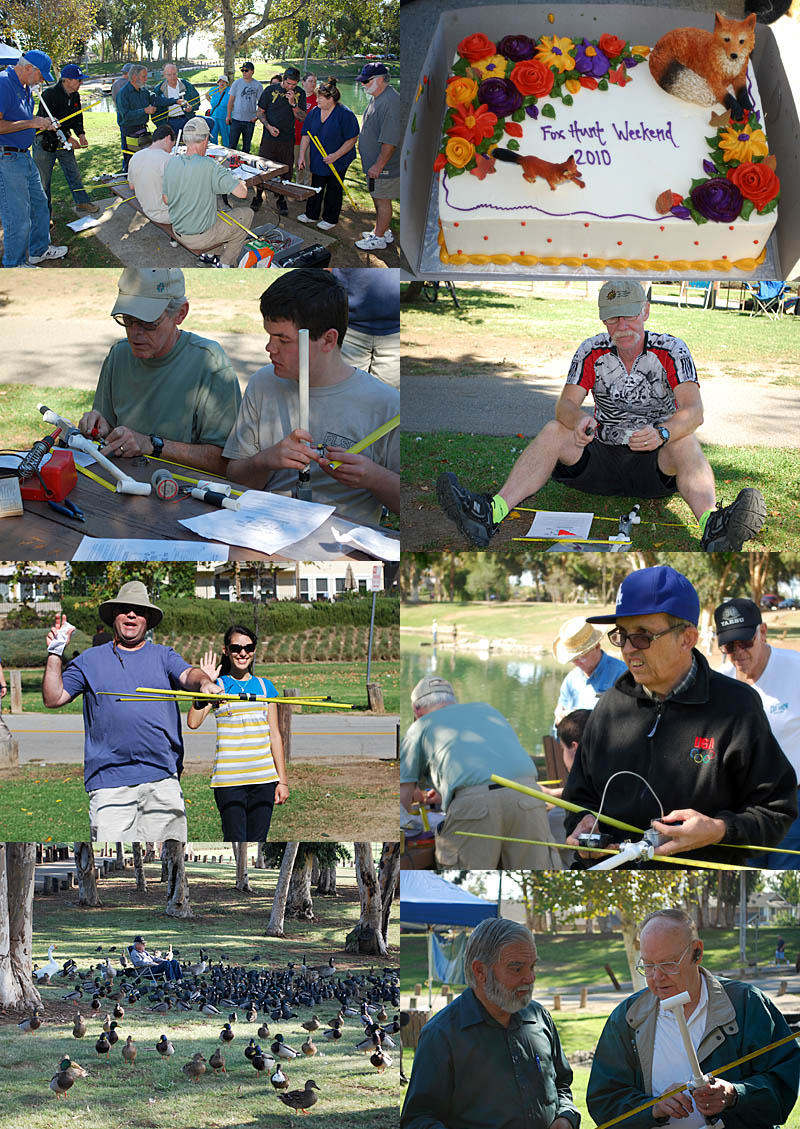

Tri-City Park ARDF on 11/6/10
Photos above and report below by Joe Moell KØOV.
A record number of first-timers showed up at Tri-City Park on November 6 to learn about on-foot transmitter hunting. Marvin Johnston KE6HTS quickly ran out of antenna and attenuator kits, so those who hadn't reserved them in advance were probably out of luck. They came from Orange County, Diamond Bar and Hemet, plus at least seven from Moreno Valley.
Nearly everyone was able to use RDF gear to find all of the four practice transmitters that were on separate two-meter frequencies and were close to the gathering area. They were all pretty simple; I resisted the urge to put one on a goose or a RC sailboat.
Unfortunately, only Tom Gaccione WB2LRH and Monique Beringer KI6RVT were brave enough to try my sample international-rules ARDF course, with five transmitters scattered throughout the park and the adjoining middle-school grounds. I thought it would be an easy course, but Tom and Monique were only able to find four of them and it took them an hour and fifteen minutes.
As always, the traditional Foxhunting Weekend cake, provided by April Moell WA6OPS, was a big hit.
Thanks to Paul Broden K6MHD, Gene Thorpe KB6CMO and all of the other Fullerton Radio Club leaders and members for sponsoring Antennas-In-The-Park again this year.
Joe Moell KØOV
Mt. Pinos ARDF Training Camp #2, 8/21-22/10
Mt. Pinos is a great place to escape the heat of the southern California lowlands. On this weekend the sky was a deep blue and completely devoid of clouds. High-SPF sunscreen was a necessity during the transmitter hunts.
McGill Campground is open again, serving as the end point for the hunts and the site of another Santa Barbara style tri-tip barbecue on Saturday evening, with s'mores for dessert. It was great to have Bruce Corning of LAOC and Dean Dods KD6I participating, even though each of them could only attend for one day.
Everyone had a great time, but we weren't completely free from the effects of Murphy's Law. Bob Cooley KF6VSE tangled in some concealed barbed wire, resulting in gashes in his legs that provided wound-closing work for April Moell, our Field Medic. My departure on Sunday was delayed by a very flat tire, but I got the spare on in time to join everyone at the Ranch House restaurant in Gorman for Sunday dinner after the 80-meter event.
Many thanks to Marvin Johnston KE6HTS for supporting ARDF Team USA by putting on two Mt. Pinos training camps this summer.
Joe Moell KØOV
Mt. Pinos ARDF Training Camp #1, 7/10-11/10
It's generally agreed that of the mapped venues for orienteering in southern California, Mt. Pinos is one of the top two. Cross-country runable forest and high elevation combine to create a great location for intensive physical training. On the weekend of July 10 and 11, Mt. Pinos was the site of a regular meet of the Los Angeles Orienteering Club (LAOC) as well as an ARDF "training camp" for advanced radio-orienteers, some of whom will be competing in the World ARDF Championships this fall.
Harley Leach KI7XF drove all the way from Bozeman, Montana to attend this practice. McGill Campground, our usual event headquarters, was closed for repaving, so everyone moved up to Mt. Pinos campground, which is almost as nice. Weather was partly cloudy, keeping the temperature very pleasant. The occasional light showers on Saturday didn't dampen the fun at all.
Marvin Johnston KE6HTS did triple duty as the course-setter for two days of ARDF, the course-setter for all of the classic orienteering courses on Saturday, and one of two LAOC electronic scoring gurus for both regular-O and radio-O. Quadruple duty, actually, if you include the tri-tip beef barbecue he organized on Saturday evening, enjoyed both by the ARDFers and some of the regular orienteers.
For the 80-meter hunt on Sunday, orienteer Brad Weyers ran side-by-side with Bob Cooley to learn from him. After the hunt, there was considerable discussion among all the participants about the optimum order for finding the transmitters. The shortest point-to-point order was 5.5 kilometers, although that required a steep climb at one point. The actual orders taken were up to 6.6 kilometers point-to-point. Some hunters bypassed fox #1 after starting even though it was only 0.75 km from the start, so they had to backtrack for it later. With their considerably different routes, it's a surprise that Bob's and Harley's times were less than 30 seconds apart.
This was mostly an event for advanced radio-orienteers, but it was also an opportunity for LAOC members to see ARDF and try it for themselves. With loaned gear, a couple of them ventured out from the campground to find the course transmitters that happened to be nearby.
After it was all over, many of the participants went to the Ranch House restaurant in Gorman for Sunday dinner. Thanks to Marvin for all his work to train up our team. Thanks also to April WA6OPS for providing First Aid as needed.
Joe Moell KØOV
Mt. Laguna ARDF Training Camp, 5/8-9/10
The Mt. Laguna Recreation Area is a wonderful place for radio-orienteering. On this May weekend, the daytime temperatures at this 6000' elevation location were mild. The only weather problem was the wind, which was strong enough to send empty tents tumbling on Sunday morning. The woodpeckers and other birds, which were busy on Saturday, were clinging to the branches on Sunday.
Marvin Johnston KE6HTS set two full-size ARDF courses, one each morning. He also put out three sprint courses to test the ability of hunters to find each transmitter before it completed its first one-minute cycle. It would have been a near impossibility for him to do all that by himself, but he had excellent help from Scott Moore KF6IKO and Les Benson W6CGE.
Marvin's two-meter course started from the west end of the map and finished at the campground on the northeast. By standard measure, the course length was 5.9 kilometers.
It's a tradition at southern California ARDF campouts that Marvin prepares his famous Santa Barbara style tri-tip roasts over hot coals. It was as good as always, and this time there were fire-toasted marshmallows for dessert, provided by April Moell WA6OPS. But where were the graham crackers?
Sunday's 80-meter hunt used the same map, start point and finish, and course length was about the same. As expected, times were much better on 80 meters because of the lack of signal reflections. The wind blew one of the 80-meter fox antennas to the ground, but both hunters found it anyway.
When it was over, most of the attendees went for a big lunch at the rustic cafe just outside the campground, avoiding the Mother's Day crowds at the restaurants in San Diego.
Joe Moell KØOV
Griffith Park ARDF on 4/10/10
A half-dozen Team California members and a couple of newcomers gathered in Griffith Park for a spring day of transmitter hunting on April 10. This was the first time we have done radio-orienteering in that park since the 817-acre wildfire there in May 2007.
Marvin's 5-fox ARDF course of about 5 kilometers was a real up-and-down challenge for the advanced hunters. Terry Newman and Christine Lutz built measuring-tape antennas with attenuators and found the nearby beginner transmitters. By then it was well into the afternoon, but they each went out on the advanced course for a while to give their new equipment a thorough test.
My 80-meter transmitter was 1.5 kilometers away and provided a relatively weak signal at the starting point. Usually, 80-meter bearings are very accurate with no signal reflections, but both hunters reported being slowed down by some false bearings along the way, possibly caused by power lines.
Thanks to everyone who participated, particularly to the hunters who helped pick up transmitters afterwards.
A bit of trivia: Did you know that the deadliest fire in the history of Los Angeles was in this same part of Griffith Park? It happened in October 1933 while 3,780 men were cleaning out brush as a depression-era work project. The foremen improperly directed them to fight the fire and many became trapped in a canyon. Over 150 were injured and 29 died. The area burned in that fire was less than six percent of the burned area of the 2007 fire.
Joe Moell KØOV
Schabarum Park ARDF on 3/13/10
ARDF Team California is working hard to get ready for the USA ARDF Championships in Ohio this coming May. We want Golden State radio-orienteers to take home the most medals. With that in mind, most of the Team California competitors were at Schabarum Regional Park on March 13, ready to be challenged by Marvin Johnston's two-meter ARDF course. At the same time, four newcomers came to the park to build measuring-tape antennas and learn how to use them to find hidden transmitters.
Welcome to Alan Hill W6ARH, John Marquiss W6JKM, Jack Myers N6WUZ and Gil Yanow K6TOS, who tried out their new tape-measure antennas on my three beginner-level transmitters. They quickly discovered that they need RF attenuation to knock down the transmitter signals when they get close, so attenuators will be their next projects.
Expecting that the two-meter advanced course would wear out the experts, I put my 80-meter hidden transmitter only about 0.7 km away. The two who went out after it made quick work of it.
Schabarum Park is an excellent location for ARDF. On this March day after a rainy winter, it was as green as it gets. Thanks to Marvin Johnston KE6HTS and April Moell WA6OPS for helping to organize a pleasant Saturday of radio-orienteering fun.
Joe Moell KØOV
Cal Poly SLO ARDF on 3/6/10
March 6 was a great day for a transmitter hunt on the campus of California Polytechnic State University in San Luis Obispo, California. Cal Poly's Amateur Radio Club teamed up with the Radio Microwave and Photonics Club (RMAP) to put on an on-foot hunt with equipment provided by Marvin Johnston KE6HTS of Santa Barbara. Hosting the event were Marcel Stieber KI6QDJ, the President of CPARC and Sam Vigil WA6NGH, Professor of Environmental Engineering at the university.
On the evening before the hunt, Marvin, Sam and Marcel scoped out the campus and did some testing. It showed, surprisingly, that signal reflections would probably not be a big problem for the beginning hunters. Marcel then made up a map (see above) with his idea of where the transmitters ought to go, and Marvin agreed. The total course length was a bit less than three miles for the perfect route. Since the campus area is relatively flat, the five 50-milliwatt MicroHunt transmitters provided strong signals for the hunters at the start.
The building workshop began at 9:00 AM in one of the campus electronic labs. It was an excellent location because it was spacious and the workbenches were already equipped with soldering irons. A dozen tape-measure yagis and a half-dozen offset-type attenuators were completed in about two hours.
At about 11:15, everyone gathered for a safety briefing, followed by instruction in radio-orienteering. The experts were started onto the course individually at five-minute intervals. Then the beginners were divided into groups of about 3 people each and a group was started every five minutes. By 2:30 PM, every hunter had returned, with his group or not, having found at least one transmitter.
According to Marvin, "This was really an enthusiastic group of people! I hope to be able to help put ARDF hunts in the future with them."
Santa Fe Dam ARDF on 2/13/10
A two-day Los Angeles Orienteering Club meet provided an opportunity for mixing in on Saturday at Santa Fe Dam Recreation Area for our first radio-orienteering session of 2010. Marvin Johnston KE6HTS divided his time between ARDF course-setting and helping LAOC with e-punch for the orienteering.
Marvin's two-meter course was somewhat similar to the one he set here last September. It allowed Max Praglin KI6SYD (pictured above) and Jay Henningan WB6RDV to improve their speed. It also provided good exercise to Scott Moore KF6IKO, who is walking as he heals from an Achilles tendon injury.
My 80-meter transmitter was 1.5 kilometers away near the west end of the lake, making that hunt much more difficult than last time. It was Max's first try on 80 meters and after he figured out how to use a loop set, he did fine.
Special thanks to April Moell WA6OPS, who not only was there to provide First Aid for radio-orienteers, but to treat some minor injuries to the Scouts and youth in the LAOC orienteering meet.
Joe Moell KØOV
Go to International-Style Foxhunting Comes To The Americas -- How we're getting the ball rolling
Go to Equipment Ideas for Radio-Orienteering -- Simple and inexpensive receiving and transmitting solutions
Go to Foxhunting for Scouts -- Let's get the kids involved
Go to Local ARDF Contacts -- Links to hams and groups that are doing international-style foxhunting in North America and around the world.
This page updated 28 February 2011
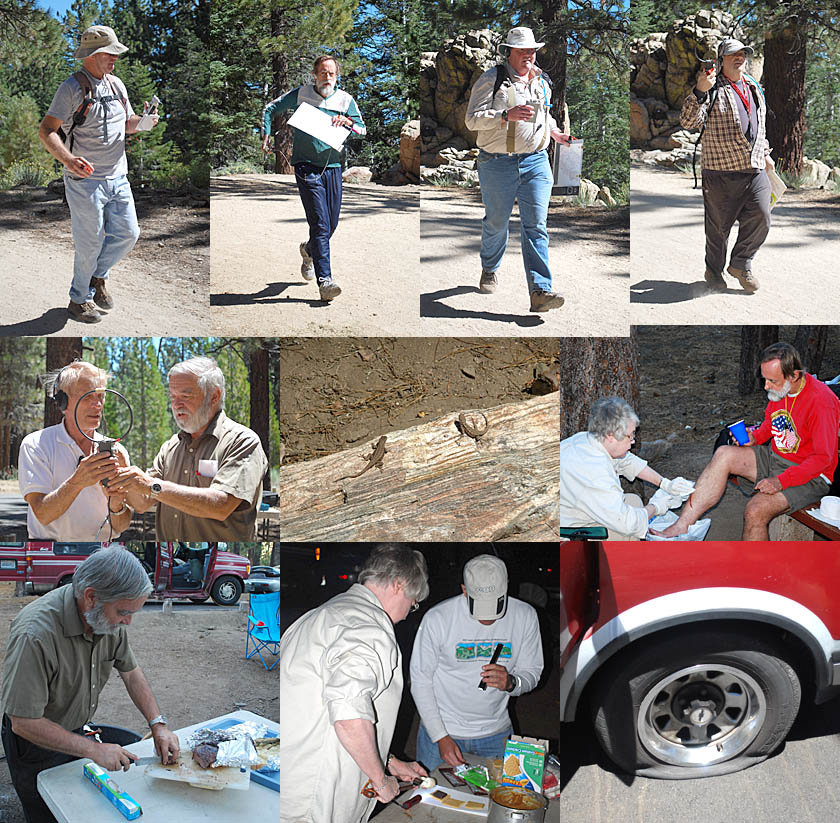
Photos above and report below by Joe Moell KØOV.
SATURDAY 2-METER COURSE RESULTS -- 5 FOXES
Name and call Foxes Time
Bob Cooley KF6VSE 5 1:32:45
201(1) 204(1) 205(1) 203(1) 202(1) F
16:36 26:22 46:11 74:04 85:13 92:45
16:36 9:46 19:49 27:53 11:09 7:32
Dean Dods KD6I 5 1:51:18
204(1) 201(1) 203(1) 205(1) 202(1) F
15:06 26:43 57:48 82:03 103:01 111:18
15:06 11:37 31:05 24:15 20:58 8:17
Bill Smathers KG6HXX 4 1:59:23
201(1) 204(1) 205(1) 202(1) F
13:29 32:15 71:04 101:38 119:23
13:29 18:46 38:49 30:34 17:45
Scott Moore KF6IKO 4 2:17:10
204(1) 201(1) 205(1) 202(1) F
37:30 56:19 86:25 123:11 137:10
37:30 18:49 30:06 36:46 13:59
SUNDAY 80-METER COURSE RESULTS -- 5 FOXES
Name and call Foxes Time
Bob Cooley KF6VSE 5 1:03:42
201(1) 202(1) 204(1) 203(1) 205(1) F
11:47 21:50 36:04 51:24 59:49 63:42
11:47 10:03 14:14 15:20 8:25 3:53
Scott Moore KF6IKO 5 1:56:35
201(1) 202(1) 204(1) 203(1) 205(1) F
16:46 32:30 49:07 91:05 110:30 116:35
16:46 15:44 16:37 41:58 19:25 6:05
Bill Smathers KG6HXX 5 2:07:26
201(1) 202(1) 204(1) 203(1) 205(1) F
14:19 28:10 45:02 75:37 118:15 127:26
14:19 13:51 16:52 30:33 42:38 9:11
Bruce Corning 5 2:40:29
202(1) 201(1) 203(1) 204(1) 205(1) F
27:01 37:13 93:14 134:34 155:01 160:29
27:01 10:12 56:01 41:20 20:27 5:28
![]()
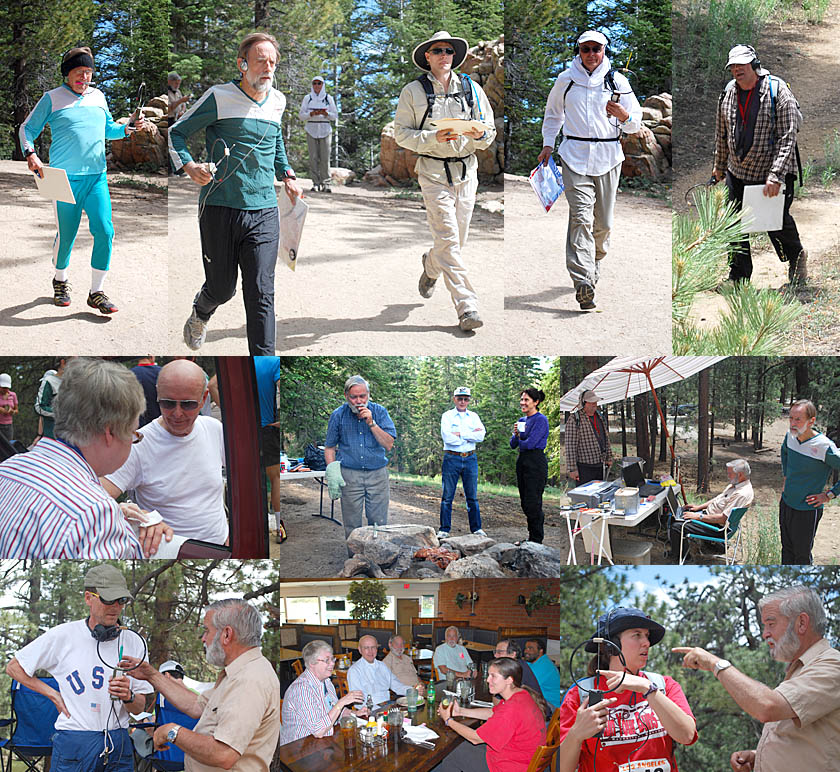
Photos above and report below by Joe Moell KØOV.
2-METER COURSE RESULTS -- 5 FOXES
Name and call Foxes Time
Bob Cooley KF6VSE 5 1:50:38
201(1) 205(1) 203(1) 204(1) 202(1) F
8:54 20:09 38:41 69:22 104:44 110:38
8:54 11:15 18:32 30:41 34:42 6:34
Harley Leach KI7XF 5 1:58:04
205(1) 201(1) 203(1) 204(1) 202(1) F
20:54 41:06 63:18 75:07 109:48 118:04
20:54 20:12 22:12 11:49 34:41 8:16
Jay Hennigan WB6RDV 5 2:00:53
201(1) 205(1) 203(1) 204(1) 202(1) F
21:36 39:18 58:38 86:27 114:24 120:53
21:36 17:42 19:20 27:49 27:57 6:29
Brad Weyers 4 3:30:00
201(1) 203(1) 204(1) 202(1) F
96:37 147:47 164:57 172:09 210:00
96:37 51:10 17:10 37:12 7:51
Bill Smathers KG6HXX 1 2:30 (approx)
80-METER COURSE RESULTS -- 5 FOXES
Name and call Foxes Time
Bob Cooley KF6VSE 5 1:47:45
205(1) 201(1) 204(1) 202(1) 203(1) F
19:43 40:43 72:44 85:27 103:00 107:45
19:43 21:00 32:01 12:43 17:33 4:45
Harley Leach KI7XF 5 1:48:09
201(1) 204(1) 202(1) 203(1) 205(1) F
11:20 42:45 57:14 87:42 102:36 108:09
11:20 31:25 14:29 30:28 14:54 5:33
Jay Hennigan WB6RDV 5 2:05:49
205(1) 201(1) 204(1) 202(1) 203(1) F
27:39 57:11 89:09 98:48 121:01 125:49
27:39 29:32 31:58 9:39 22:13 4:48
Bill Smathers KG6HXX 3 2:22:01
201(1) 203(1) 204(1) F
36:25 93:02 116:33 142:01
36:25 56:37 23:31 25:28
![]()
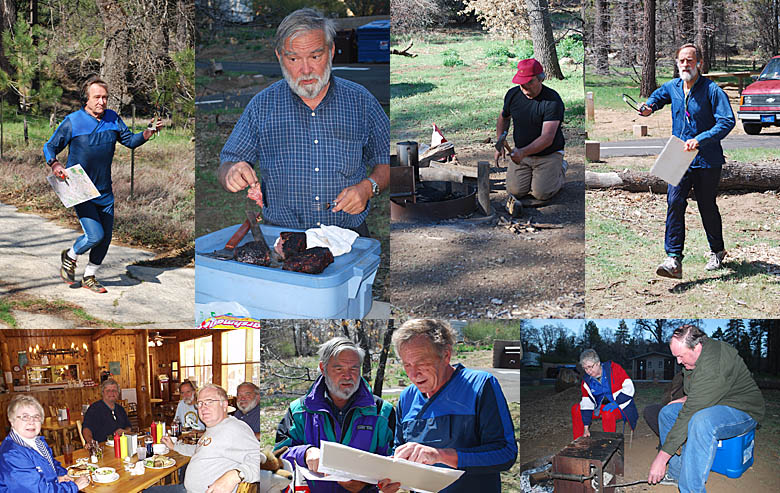
Photos above and report below by Joe Moell KØOV.
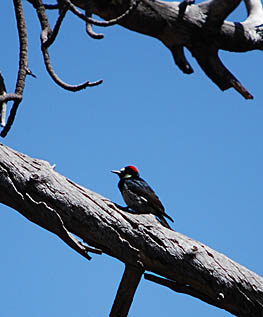
ARDF 2-METER COURSE RESULTS -- 5 FOXES
Name and call Foxes Time
Bob Cooley KF6VSE 5 2:00:43
201(1) 204(1) 205(1) 203(1) 202(1) F
16:39 39:07 68:13 91:40 113:59 120:43
16:39 22:28 29:06 23:27 22:19 6:44
Jay Hennigan WB6RDV 5 2:07:56
201(1) 203(1) 205(1) 204(1) 202(1) F
20:15 41:06 62:39 80:03 121:52 127:56
20:15 20:51 21:33 17:24 41:49 6:04
Bill Smathers KG6HXX 3 2:24:42
201(1) 205(1) 202(1) F
49:05 93:01 128:48 144:42
49:05 43:56 35:47 15:54
ARDF 80-METER COURSE RESULTS -- 5 FOXES
Name and call Foxes Time
Jay Hennigan WB6RDV 5 1:12:09
201(1) 204(1) 203(1) 202(1) 205(1) F
9:23 14:51 26:14 41:35 67:01 72:09
9:23 5:28 11:23 15:21 25:26 5:08
Bob Cooley KF6VSE 5 1:20:30
201(1) 204(1) 203(1) 202(1) 205(1) F
16:01 25:58 44:47 53:21 75:21 80:30
16:01 9:57 18:49 8:34 22:00 5:09
![]()
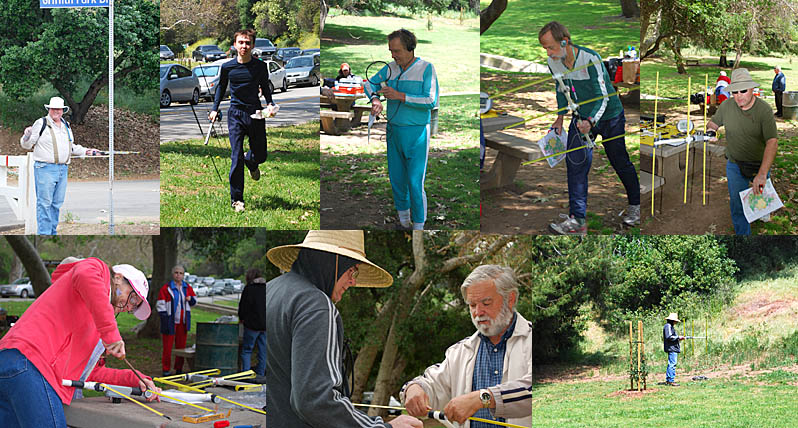
Photos above and report below by Joe Moell KØOV.
ARDF 2-METER COURSE RESULTS -- 5 FOXES
Name and call Foxes Time
Jay Hennigan WB6RDV 5 1:12:30
Bob Cooley KF6VSE 5 1:14:44
Bill Smathers KG6HXX 4 3:03:01
Tom Gaccione WB2LRH 3 1:45:02
Jay Thompson W6JAY 3 2:19:32
Scott Moore KF6IKO 3 2:45:29
T. William Newman AE6JR 2 1:01:28
Christine Lutz KC6ECV 1 0:27:32
80-METER HUNT RESULTS (1 FOX)
Name and call Time
Bob Cooley KF6VSE 0:50:33
Jay Hennigan WB6RDV 1:07:01
![]()
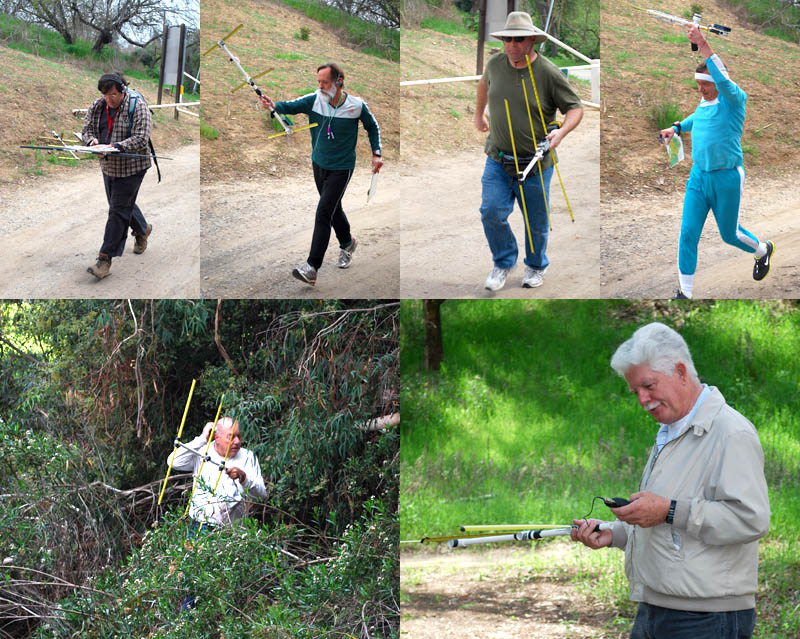
Photos above and report below by Joe Moell KØOV.
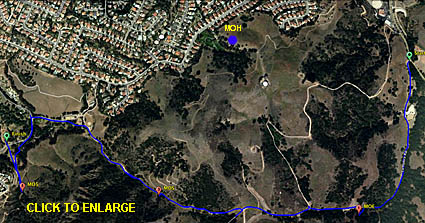 Starting point for the advanced hunt was on the southern edge of the mapped site at 640' elevation. Marvin's course was designed to provide route choice challenges, but unfortunately, two of his transmitters failed and removed the choices for most of the hunters. At right is the GPS route of Jay Hennigan WB6RDV, oriented with east toward the top. He found MOE, MOS and MO5 in that order, mostly via the main trails, and got to the finish at 600' eleveation. But he never heard MOH, which would have given him a route dilemma plus the added difficulty of traversing 1100' elevation hills. The only hunter to hear and track down the extremely weak signal from MOH was Bob Cooley KF6VSE. Transmitter MOI, which was further north (outside the GPS photo area), was not on the air to give hunters a longer overall run.
Starting point for the advanced hunt was on the southern edge of the mapped site at 640' elevation. Marvin's course was designed to provide route choice challenges, but unfortunately, two of his transmitters failed and removed the choices for most of the hunters. At right is the GPS route of Jay Hennigan WB6RDV, oriented with east toward the top. He found MOE, MOS and MO5 in that order, mostly via the main trails, and got to the finish at 600' eleveation. But he never heard MOH, which would have given him a route dilemma plus the added difficulty of traversing 1100' elevation hills. The only hunter to hear and track down the extremely weak signal from MOH was Bob Cooley KF6VSE. Transmitter MOI, which was further north (outside the GPS photo area), was not on the air to give hunters a longer overall run.
ARDF 2-METER COURSE RESULTS -- 5 FOXES
Name and call Foxes Time
Bob Cooley KF6VSE 4 1:34:26
Jay Hennigan WB6RDV 3 0:36:27
Scott Moore KF6IKO 3 1:52:18
Tom Gaccione WB2LRH 3 2:02:49
80-METER HUNT RESULTS (1 FOX)
Name and call Time
Jay Hennigan WB6RDV 0:09:14
Bob Cooley KF6VSE 0:11:45
![]()
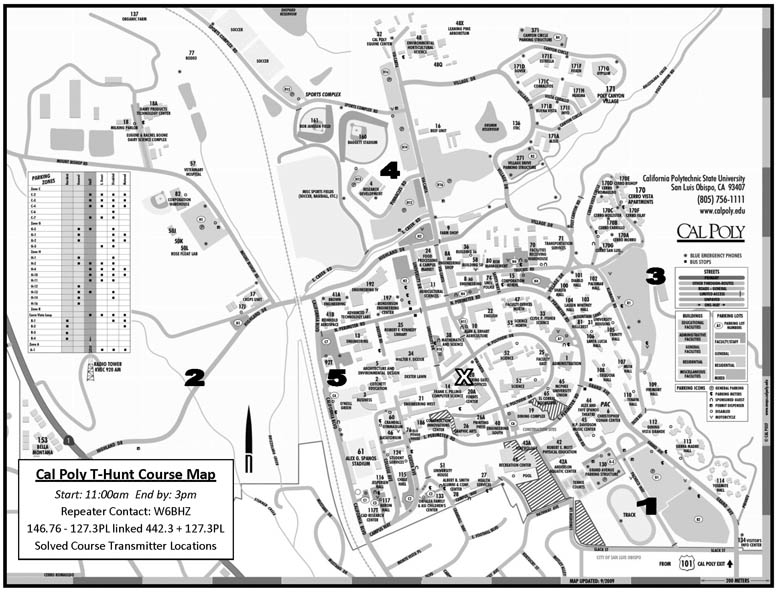
ARDF 2-METER COURSE RESULTS -- 5 FOXES
Name and call Time Foxes
Jay Hennigan WB6RDV 1:04:00 5
Chris Nelson 1:44:00 5
Bill Blodgett KE6RKT 2:05:25 5
Jeff Lewis 2:30:45 5
Charles DeCraene N6DIQ 2:45:45 5
Bill Smathers KG6HXX 1:55:00 4
Scott Moore KF6IKO 1:57:50 4
John Chen KI6QDF 3:01:00 2
with Garrett Dong KI6YML
Mark Smith KR6ZY 0:42:00 1
with Mike Civerolo
Alex Hempy KI6VPT 0:46:00 1
Javen O'Neal KF7HNI 1:05:00 1
![]()
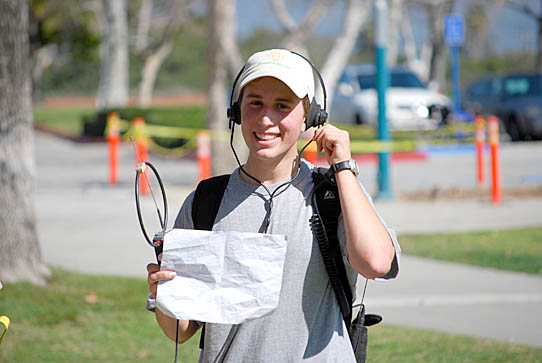
Photo above and report below by Joe Moell KØOV.
 This winter's pattern of heavy rains had taken a breather, so we had dry shirt-sleeve weather. There was no standing water behind the dam and very little mud on the course. It was fun to watch an industrious hummingbird gathering spiderweb material from beneath the picnic tables and adding it to her nest in the big tree above (photo at right).
This winter's pattern of heavy rains had taken a breather, so we had dry shirt-sleeve weather. There was no standing water behind the dam and very little mud on the course. It was fun to watch an industrious hummingbird gathering spiderweb material from beneath the picnic tables and adding it to her nest in the big tree above (photo at right).
ARDF 2-METER COURSE RESULTS -- 5 FOXES
Name and call Foxes Time
Jay Hennigan WB6RDV 5 0:48:51
Max Praglin KI6SYD 5 1:12:10
with Mark Mallick KJ6CUV
Scott Moore KF6IKO 5 2:06:05
80-METER HUNT RESULTS (1 FOX)
Name and call Time
Jay Hennigan WB6RDV 0:23:20
Scott Moore KF6IKO 0:51:55
Max Praglin KI6SYD 1:18:15
![]()
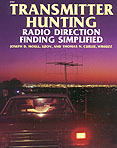 Go to Southern California ARDF -- Current radio-orienteering news and results
Go to Southern California ARDF -- Current radio-orienteering news and results Back to the Homing In home page
Back to the Homing In home page